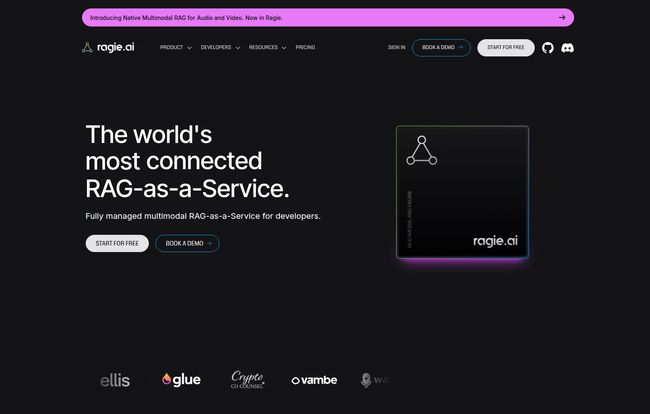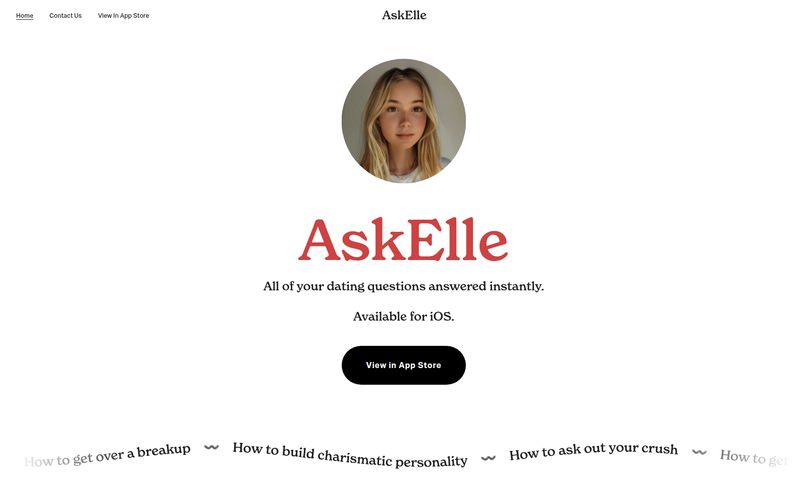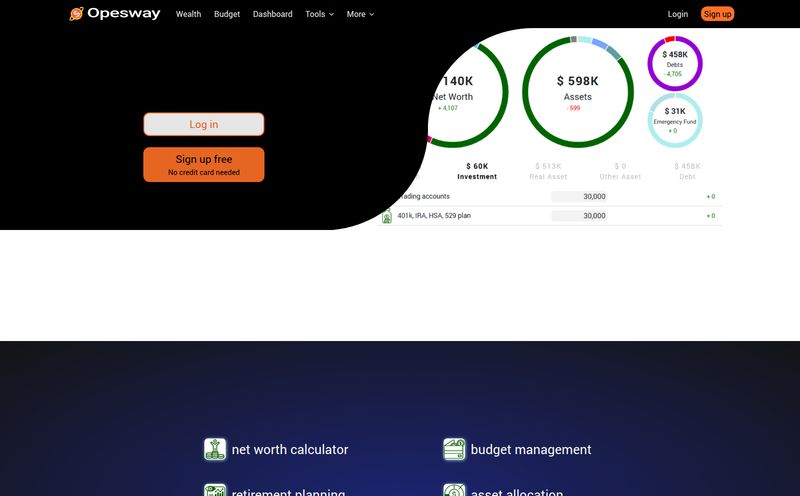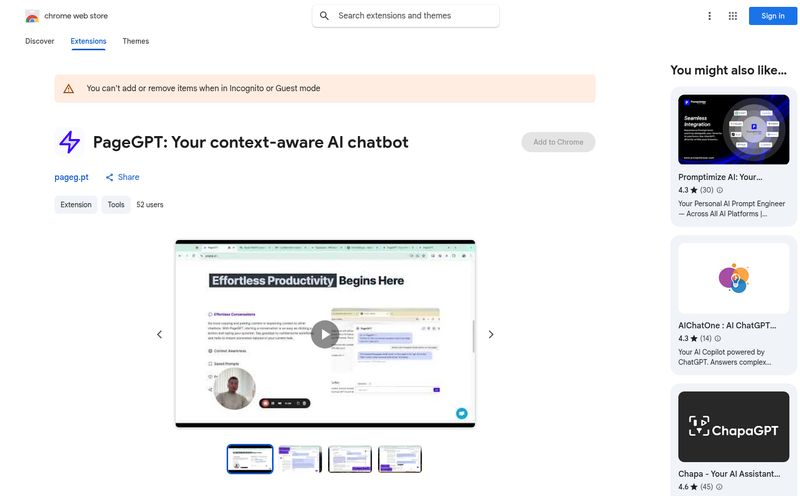If you're in the AI dev space right now, you can't throw a rock without hitting a conversation about Retrieval-Augmented Generation, or RAG. It's the secret sauce that lets our fancy LLMs talk about specific, private data without having to be retrained on the entire internet. And for good reason! It's powerful. But let's be honest, building a robust RAG pipeline from scratch is... well, it's a pain. A massive one.
I’ve spent more late nights than I'd care to admit wrestling with data chunking strategies, trying to get vector embeddings just right, and debugging why my retrieval is pulling up the most random, irrelevant documents. It’s a rabbit hole. You start by thinking, "I'll just whip something up with LangChain," and three weeks later you're questioning all your life choices. Fun times.
That's why my ears perked up when I stumbled upon Ragie. The landing page hits you with "The world's first managed, multimodal RAG-as-a-service." Bold claim. My inner skeptic immediately flared up, but my inner tired-of-building-pipelines developer was intrigued. A fully managed service that handles all the messy bits? Sign me up for a closer look.
First Off, What's RAG Again? A Quick Refresher
Before we go any further, lets just make sure we're on the same page. Think of an LLM like ChatGPT as a brilliant, well-read intern. They know a ton about general topics. But if you ask them about your company's internal Q3 sales report, they'll just stare back blankly. RAG is the process of giving that intern a filing cabinet (your data), a smart assistant to find the right file (the retriever), and telling them, "Hey, before you answer, check this specific document."
It grounds the AI in reality—your reality. This is how you build chatbots that can answer questions about your product documentation, or tools that can summarize legal contracts. The problem is, building that filing cabinet and the smart assistant is the hard part. That's the pipeline.
Enter Ragie: Your RAG Pipeline on Autopilot
Ragie positions itself as the solution to that pipeline headache. It's a platform designed to take all the complicated, time-sucking infrastructure work off your plate. Instead of you having to figure out the best way to parse a PDF, chunk a 2-hour long video, or index data from Notion, Ragie just... does it. It’s RAG, but delivered as a service, much like you'd use Stripe for payments or Twilio for SMS.
You connect your data sources, and Ragie handles the ingestion, chunking, indexing, and provides you with a simple API to perform the retrieval. This means you can focus your engineering firepower on what actually makes your application unique, not on the plumbing.
The Features That Actually Make a Difference
Okay, so what’s under the hood? A lot of buzzwords get thrown around in AI, but some of Ragie's features genuinely address common developer pain points.
Connecting Your Data Without the Drama
One of the first hurdles in any RAG project is just getting your data in. Ragie seems to get this. They have pre-built connectors for the big ones like Google Drive, Notion, and Confluence. This is huge. Writing custom loaders for these platforms, especially handling authentication and updates, is a project in itself. Ragie also promises automatic syncing, so as your documents in Notion get updated, your AI's knowledge base stays fresh without you needing to run a cron job. That's a nice touch.
Indexing That's More Than Just Vectors
This is where things get interesting. Ragie claims to be multimodal, meaning it can handle not just text, but images, audio, and video too. This opens up some seriously cool possibilities. Imagine building an app that can search through your company's Zoom call transcripts and the slides that were presented. That’s a powerful step up from text-only RAG.
They also boast about advanced features like chunk reranking, hybrid search (combining keyword and vector search), and entity extraction. These aren't just fancy extras; they are critical for accuracy. Bad retrieval is the number one killer of RAG apps, and features like these are what separate a cool demo from a production-ready tool that people can rely on.
Let's Talk Turkey: The Ragie Pricing
This is always the make-or-break moment, isn't it? A tool can be amazing, but if the pricing is out of touch with reality, it's a non-starter. I took a good look at Ragie's pricing page, and it seems pretty thoughtfully structured.
| Plan | Price | Who It's For | Key Limits |
|---|---|---|---|
| Free | $0 | Hobbyists, personal projects | 1,000 pages, 10 hours audio/video |
| Starter | $100 / month | Small-scale apps, startups | 10,000 pages, pay-as-you-go |
| Pro | $500 / month | Production apps, SMEs | 50,000 pages, pay-as-you-go |
| Enterprise | Custom | Large-scale, high-security needs | Custom limits, dedicated infra |
The Free tier is genuinely useful for trying things out, which I always appreciate. The Starter plan at $100/month feels like the sweet spot for indie hackers or small startups looking to validate an idea without a massive upfront investment. Once you move to the Pro tier, you're clearly in production territory. One thing to watch is the add-on cost for connectors—the first one's free, but then it's $250/month for each additional one. That could add up, so you need to factor it in.
The Big Question: DIY vs. Ragie
So, why pay for Ragie when you can build it yourself with open-source tools? This is the core debate. In my experience, the cost of 'free' open-source software is never zero. It costs you engineering time. A lot of it.
Think about the salary of one, maybe two, AI/ML engineers. How many weeks would it take them to build a system that has multimodal support, automatic syncing, advanced re-ranking, and is scalable and secure? Probably months. Suddenly, that $500/month Pro plan doesn't seem so expensive. It’s the classic build vs. buy argument.
If your company's core business is building RAG infrastructure, then by all means, build it. But if your business is, say, an AI-powered legal assistant, your value is in the application layer, not the data pipeline. Using a service like Ragie is like using AWS instead of building your own data center. It lets you stand on the shoulders of giants and move way, way faster.
So, Should You Use Ragie?
Look, no tool is a silver bullet. If you're just building a tiny little chatbot for a personal site with three text files, Ragie is probably overkill. But if you're a developer or a company looking to build a serious, scalable, and accurate generative AI application, Ragie seems like a very compelling proposition.
The main upsides are the massive savings in engineering time and the access to advanced retrieval features out of the box. The downsides? You're introducing a dependency on a third-party service, and for very high-volume use cases, the costs could become a factor to monitor closely. It’s a trade-off, as with all things in tech.
For my money, the ability to bypass the most frustrating parts of RAG development and get straight to building a great user experience is a powerful advantage. It feels like a significant step forward in making sophisticated AI accessible to more developers.
Conclusion
Building with AI is supposed to be about creating magical user experiences, not getting bogged down in the nitty-gritty of data pipelines. Tools like Ragie represent a shift in the ecosystem towards specialization, allowing developers to offload the complex infrastructure to experts. It turns the arduous task of building a RAG system from a multi-month research project into a weekend integration. And in the fast-moving world of AI, that speed can be everything.
I'm genuinely excited to see how this space evolves. Managed services could be what truly unlocks the next wave of innovative AI applications, by freeing up the builders to just... build.
Frequently Asked Questions About Ragie
Is Ragie just for large companies?
Not at all. With a free tier for personal projects and a $100/month Starter plan, it's very accessible for individual developers, indie hackers, and small startups. The Enterprise plan is there for larger companies with specific security and scale requirements, but it's not the only option.
How is Ragie different from open-source libraries like LangChain or LlamaIndex?
Think of it this way: LangChain and LlamaIndex give you the toolbox and the raw materials to build a car engine. Ragie gives you a fully assembled, high-performance engine that you just need to drop into your car. Ragie is a fully managed service that uses principles found in those libraries but handles all the hosting, scaling, data ingestion, and maintenance for you.
What does 'multimodal' actually mean in this context?
It means Ragie can understand and process more than just text. You can feed it text documents, images, audio files, and even videos. The service will index the content from all these different formats, allowing your AI application to retrieve information from a company meeting's video just as easily as it would from a text-based PDF.
How does the pricing for data work?
It's based on a few factors. You get a certain number of 'pages' included in your plan (e.g., 50,000 in the Pro plan). A page is roughly 1,000 words. Images, audio, and video are billed separately, usually on a per-image, per-minute, or per-GB basis. It's a pay-as-you-go model for usage beyond your plan's included amounts, which is pretty standard for cloud services.
Is my data secure with Ragie?
According to their site, security is a major focus. They talk about ensuring data security and compliance. For businesses with strict requirements, the Enterprise plan offers options like a dedicated SaaS instance, which provides a higher level of isolation and control over your data environment.
What if I have a ton of very small documents?
This is a common question with RAG systems. Ragie's FAQ on their pricing page mentions they have smart ways of handling this to avoid unfair billing. They seem to aggregate smaller documents, so you aren't penalized for having a dataset with thousands of tiny files instead of a few large ones. It’s best to check their latest documentation for the exact mechanics.




